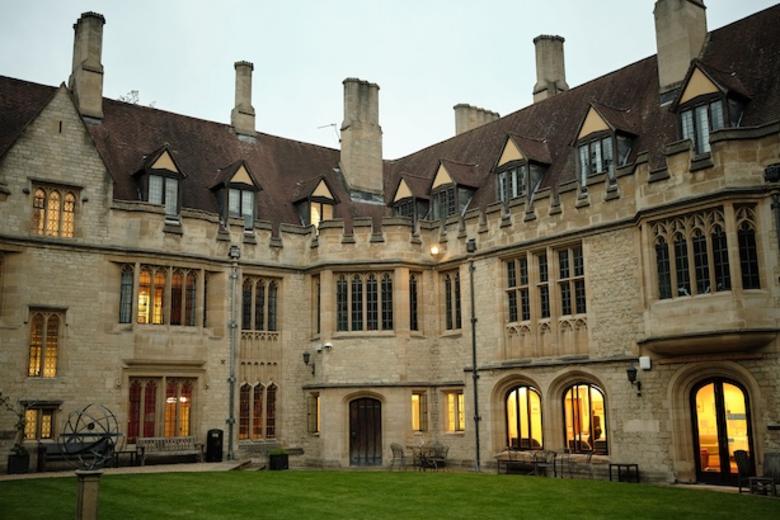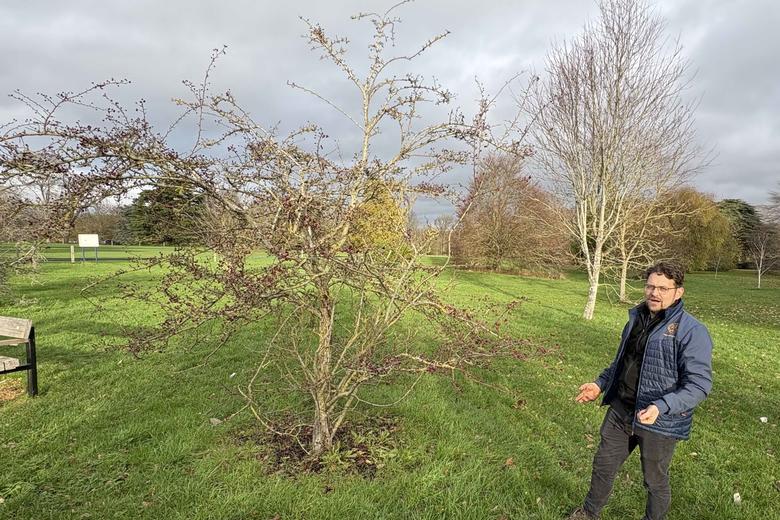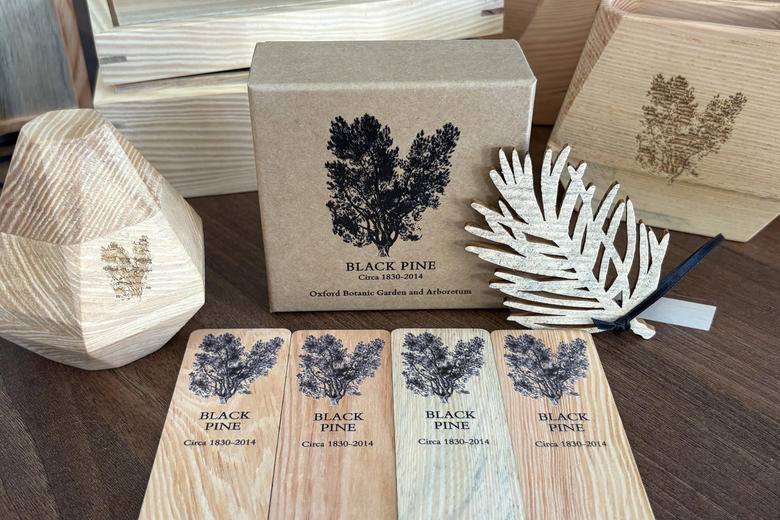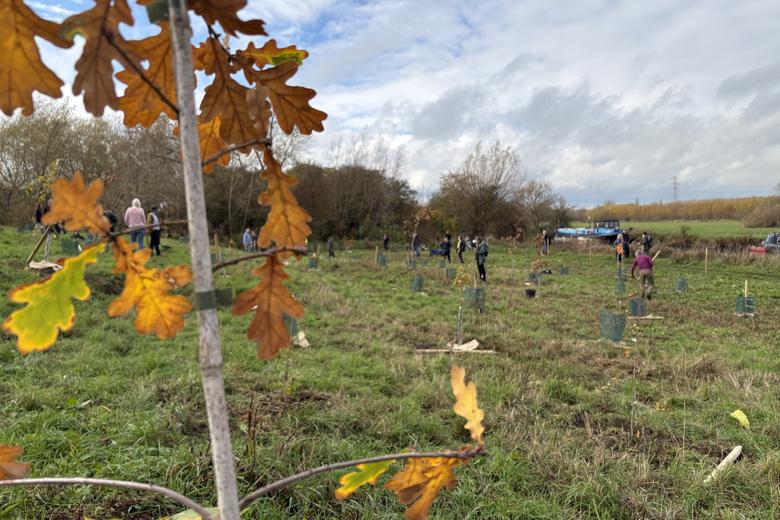ACORN MAN

ACORN MAN
Benedict Pollard recounts how he is harvesting specimen acorns from special oak trees, to turn them into great oak trees of the future.
Published: 1 November 2022
Author: Richard Lofthouse
Share this article
Benedict Pollard (St Hugh's, 1992) has been passionate about oaks since the late 1980s, when he started planting them in his 'magical' childhood garden in Berkshire.

Benedict began in 2015 to harvest the acorns from some of the UK's oldest specimen oak trees, with a view to growing a new generation while raising public awareness of just how special oak trees are.
For example, a former colleague of Benedict's at Kew Gardens, Dutch botanist Aljos Farjon, published a book in 2017 called Ancient Oaks in the English Landscape, in which he says that there are more ancient oak trees in England than in the rest of Europe put together – largely on account of medieval and Tudor deer parks, noble hunting rights historically, and the custody of private estates.
Britons for the most part are ignorant of this core fact, despite perhaps knowing that Britain is also one of the most deforested landscapes in the world.
Benedict's first specimens, now seven years old, are touching a height of four metres, planted in large pots and ready to find homes.
Benedict’s original degree at Oxford was in biological sciences (‘I mostly took the plant options where I could…’)
He’s also exceedingly well travelled and has helped with conservation and research in places like Cameroon, where he went with support from the Oxford-based charity Earthwatch.
He says that this year, 2022, has been a mast year, or year of plenty.
There are too many acorns to harvest and he has thousands, very carefully stored in neat, hessian sacks and recorded in a note book that takes its place in a meticulous row of notebooks going right back to his first specimen collections many years ago.
He’s now up to BP1802, he notes. Alongside it he scribbled, ‘massive!’ measuring a girth of 10.63 metres, and the fact that it is not Quercus robur but Quercus petraea– those two being the two species of oak tree that are native to the UK, the pedunculate and sessile oaks respectively.
Benedict has also worked professionally in landscaping over much of the last 15 years and oversaw all the planting and ecology at an 850-acre estate in Gloucestershire.
Tens of thousands of trees and shrubs were planted, and he remembers ordering a single tree that occupied the entire payload of an articulated lorry – these days there is almost no limit on the ability of a developer to create an ‘instant’ mature wooded landscape, money permitting.
By those standards Benedict’s trees remain small yet some of the first generation of acorns that he and his team germinated in 2015 are already hitting four metres in height, and cost approximately £400 to £500 each, while others start from £50 and measure approximately one metre. The provenance of every tree is linked back to its parent oak.
He has hundreds of oak trees at three sites in Oxfordshire, Somerset and Gloucestershire, the germination and early year care in the hands of well-known horticulturalist James Harris of Mallet Court Nursery.
One of the key nurseries is Nicholsons Lockhart Garratt in North Aston, Oxfordshire, custodian of approximately 200 of Benedict’s largest oaklings.
Benedict reports that this year he’s added a large number of new parent oak trees to his crop, from eight or nine new counties such as Cambridgeshire, Devon and Northamptonshire. These parent trees reside in a mix of different landscapes from stately homes, magnificent parkland settings, castles, farms and even a very special ancient woodland owned by a parish council in Essex.
He says that his approach has evolved 'mostly by serendipity, synchronicity, word of mouth and recommendation', but he does also use the (online) Ancient Tree Inventory as a helpful accompanying guide.

Individual landowners have been very receptive so far, because –perhaps surprisingly– no one else has ever taken such a focused interest in particular ‘named’ or other trees within these ancient landscapes.
There is also a conservation and horticultural and scientific angle, explained on Benedict’s website.
It includes many subsidiary aims within the broader scope of a commercial venture, such as helping researchers find out more about what makes for a mast year – a phenomenon not entirely understood by scientists, and for instance ‘sampling of the coleopteral fauna (beetles) of individual parent oaks and ancient wood pasture, with a view to creating habitat connectivity.’
‘I am not targeting the commercial forestry market,’ he says.
Instead, Benedict is focused on creating stories around particular oak trees in the often beautiful settings of particular estates, and then allowing potential customers to obtain oaklings from those same trees to plant, often for a commemorative or memorial purpose.
He is, in effect, branding trees that until now may have been locally ‘known’ but not necessarily celebrated.
At Bryan Brampton in Herefordshire, ‘The Sentinel’; at Radley College near Oxford, ‘The Radley Oak’; in Berkshire the ‘Sheepshow Oak’ and at Helmingham Hall in Suffolk an Oak known as one of ‘The Three Sisters’. And of course many more in a swelling inventory.
In a University of Oxford initiative launched in October, Benedict is helping to extend the University-owned Wytham Woods by creating a new wood, Bear Wood, in a broad public-facing initiative that will gather pace in the winter of 2023.

He has supplied over 1,200 acorns from two 580-year-old maiden oaks from nearby Kirtlington Park, an ancient pasture woodland. These have been offered up to supporters and friends of Wytham, and members of the public, who will be able to acquire and plant their own special oaks.
In 2023, they will be able to visit Bear Wood to plant their own oaklings, a pre-existing name for the hill adjacent to the existing wood.
Right now it is a field of rank long grass, so will be transformed into a much more diverse and welcoming place.
In another University project, one of Benedict’s loveliest specimen saplings was planted by University Vice Chancellor, Professor Dame Louise Richardson, near the Danby Arch of the Oxford Botanic Garden, earlier this year, as a commemoration of the 400th Anniversary of the Garden.
It was grown from an acorn collected on 1st October 2015 from a magnificent c. 800-year old maiden oak at the home of the founder of the Botanic Garden, Sir Henry Danvers, who without much doubt would have known that very tree himself.
Benedict says that his surname 'Pollard' is a convenient talking point, citing a note he found in a journal from the 1980s, that 'Pollarding prolongs the life of trees, so many of Britain's most ancient trees are pollards (Rackham 1980).' One reason for pollarding, or cutting the branches from the base of the tree upwards, was to place new growth out of the reach of deer, who are very partial to oak leaves.
The core question, whether a magnificent oak tree is more likely than any other oak tree to beget more magnificent oak trees, remains a grey area.
But there are heritable characteristics and studying a batch of Benedict’s young oaks clearly shows family traits – they are not all the same.
All things being equal – and there are caveats within that phrase such as the current risk posed by various environmental threats – Benedict’s oaks, having had a roaring start to life in the hands of professional care and nurture, stand every chance of going on to be the ancient specimens of the future, continuing to preserve and expand one of the unsung characteristics of the English landscape.
A botanist by training, with an MA degree in Biological Sciences from the University of Oxford (1996), Benedict Pollard was elected a Fellow of the Linnean Society in 2000.
He worked at the Royal Botanic Gardens, Kew from 2000 to 2005, and participated in or led over 15 botanical and ethnographical expeditions to the rainforests of Cameroon, Gabon, Sierra Leone, Guinea and Republic of Congo (1996 to 2013). From 2008 to 2021 he oversaw the landscaping and ecology at ‘The Lakes by yoo’ in Gloucestershire – a development that recently won a notable sustainability award. He founded Mighty Fine Oaks in 2015.















